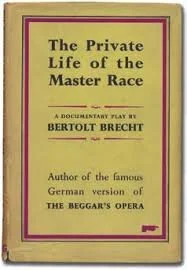A precursor to contemporary docudramas such as The People’s Temple, The Laramie Project, The Exonerated and the works of Anna Deveare Smith.
Bertolt Brecht’s
Fear & Misery of the Third Reich
Of his play Fear & Misery of the Third Reich (Furcht und Elend des Dritten Reiches) Bertolt Brecht wrote: “ … what a fragile foundation fear and misery are … how ineffectual terror is bound to be, in fact, how inevitably it must create resistance, even in sections of the population that originally welcomed it with cheers.” More than a historical recording of the past, this play shows us how fear and intimidation can impact a society - how thought and action can become paralyzed in a fascist state - and it urges us to resistance and action. Eighty-one years later the play’s relevance to our own time is painfully obvious, and Brecht’s words resonate powerfully and prophetically. Beginning in 1933 with the first day of Hitler’s regime and concluding with the invasion of Vienna in 1938, Brecht’s drama paints a chilling portrait of everyday life under the Nazis. In 24+ scenes, the documentary play gives a cross-section of all German society, reveals the brutality, terror and resistance of every class of the population, in a series of intimate snapshots depicting the impact of the National Socialist dictatorship.
Five scenes, The Chalk Cross, Judicial Process, Occupational Disease, The Jewish Wife and The Spy, were originally titled Die Angst-Spiritual Upsurge of the German People Under Nazis, and the formed the nucleus from which Brecht built up his full script. From 1935 to 1938 that script grew from five to 17 to 27 playlets (the number of scenes eventually totaled 30, with more in outline form). The play has undergone many permutations throughout the years, as scenes were added, performed individually and in groups, and arranged in different orders with different translators. John Willett’s masterfully brutal English translation of Fear and Misery first published in 1983 includes 24 scenes. The play’s production history is equally checkered. The first official production, comprised of only eight scenes, was presented in a 1938 Paris production entitled 99%, an ironic reference to the fact that 99% of the German voters voted Nazi in the March 1936 elections. In 1940, the BBC broadcast a few scenes entitled Under the Crooked Cross. Most notably, the American wartime adaptation The Private Life of the Master Race (surviving now only in Eric Bentley’s translation) reordered the scenes into three parts, added a chorus, new introductory verses and an onstage German panzer.
Graphics by Christine U’Ren (after George Grosz)
In its depiction of an entire society at a particular time in history, the scope of Brecht’s play has never been equaled.
Of Local Note: The American version The Private Life of the Master Race in the translation by Bentley had its world premiere by the Little Theatre in Wheeler Auditorium at UC Berkeley on June 7-June 9, 1945 - four performances in three days. Under the auspices of the Department of Dramatic Arts and its Little Theatre, Henry Schnitzler, son of the Austrian writer Arthur Schnitzler, directed a cast in all 17 scenes of the Bentley translation. The play was done as part of the official program for delegates to the United Nations conference taking place in San Francisco. Schnitzler sent Brecht a telegram after the opening saying “the audience followed every scene with profound attention.”

